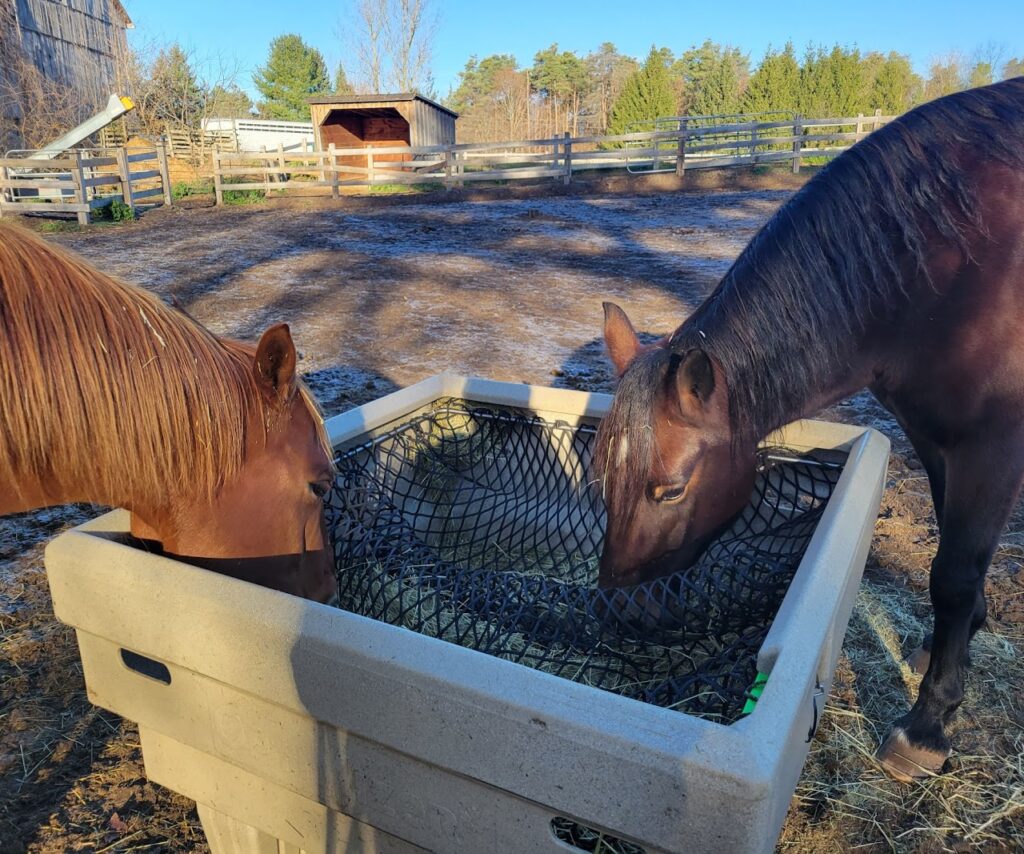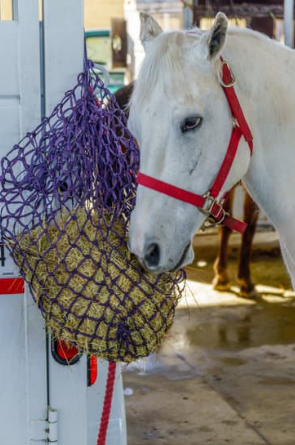
Horses have evolved to graze for upwards of 16-18 hours per day. Unfortunately, modern management tends to revolve around meal feeding. There is a significant amount of research on how encouraging slow feeding improves equine welfare. This is typically done with a hay net or slow feeder. This article will summarize the research on hay nets and slow feeders as well as discuss the best option.
Hay nets were developed with the goal of increasing the time a horse spends consuming forage. They come in a variety of sizes and are made of webbed fabric. However, the one major downfall of hay nets is the unnatural feeding posture when the horse must eat with their head raised. There are many studies that have proven that when hay nets are used, we can increase the foraging time for the horse. But if you have ever shopped for a hay net or slow feeder you know there are many options!
One study compared hay net hole sizes (15.2cm, 4.4cm and 3.2cm). The researchers found that the hay nets with small and medium sized holes were effective at reducing the rate of forage consumption when compared to the control group which was fed with no hay net at all. This has been well documented with a variety of hay net sizes, as well as slow feeders – therefore, we know we can use these tools to extend foraging time. When evaluating hay nets in outdoor herd housing there is a reduction in forage intake rate and no increase in negative interactions between the horses. Unfortunately, the main negative aspect to hay nets is that the horse must eat with their head in a raised position. This is a key reason why the research has begun to recommend slow feeders that allow natural posture.
When a slow feeder is used, it incorporates a hay net but allows the horse to eat in a more natural grazing position i.e., with their head lowered. In a study that compared slow feeders and hay nets, the slow feeders were found to promote more desirable behaviours. The stereotypic behaviours in horses using a slow feeder were decreased and their “friendliness” towards humans increased. When comparing these two, there was also increased frustration when a hay net was used compared to a slow feeder that allowed for a natural grazing position.
In conclusion, promoting natural grazing behaviour in horses is a key aspect of their welfare. It promotes better gastrointestinal health as well as decreased undesirable behaviours. We can reduce their rate of forage intake to ensure we are maximizing the time they have forage available without promoting obesity. Due to the unnatural grazing position that hay nets can result in, slow feeders are more strongly recommended.


The first image (left) is two horses eating out of an OptiMizer slow feeder. This feeder allows the horses to eat with their head in a natural lowered position. The second image (right) is a horse eating out of a hay net. As you can see in the image the horse is unable to forage with their head in a natural position.
References:
Glunk, E. C., Hathaway, M. R., Grev, A. M., Lamprecht, E. D., Maher, M. C., & Martinson, K. L. (2015). The effect of a limit-fed diet and slowfeed hay nets on morphometric measurements and postprandial metabolite and hormone patterns in adult horses. Journal of animal science, 93(8), 4144-4152.
Glunk, E. C., Weber, W. J., & Martinson, K. L. (2013). The effect of hay net design on rate and amount of forage consumed by adult horses.
Raspa, F., Roggero, A., Palestrini, C., Marten Canavesio, M., Bergero, D., & Valle, E. (2021). Studying the shape variations of the back, the neck, and the mandibular angle of horses depending on specific feeding postures using geometric morphometrics. Animals, 11(3), 763.
Rochais, C., Henry, S., & Hausberger, M. (2018). “Hay-bags” and “Slow feeders”: Testing their impact on horse behaviour and welfare. Applied Animal Behaviour Science, 198, 52-59.